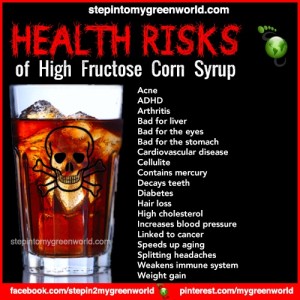You might think that the increase of the use of “high-fructose corn syrup during the past 30 years, would be safe. High Fructose Corn Syrup (HFCS) is an “artificial” sweetener made from a complex process with corn; a process of brewing, separating, breaking down, injecting enzymes, filtering, mixing and blending. Sounds safe enough, doesn’t it?
High fructose corn syrup is extremely soluble and mixes well in many foods. It is cheap to produce, sweet and easy to store. It’s used in everything from bread to pasta sauces to bacon to beer as well as in “health products” like protein bars and “natural” sodas.
HFCS is less expensive, lasts longer, and is more easily transported and handled than natural sugar; thus food producers prefer it for their manufacturing processes.
Research has shown that “high-fructose corn syrup” goes directly to the liver, releasing enzymes that instruct the body to then store fat! This may elevate triglyceride (fat in blood) levels and elevate cholesterol levels. Because it is metabolized by the liver, fructose does not cause the pancreas to release insulin the way it normally does. Fructose converts to fat more than any other sugar. Fructose reduces the affinity of insulin for its receptor, which is the hallmark of type-2 diabetes.
Some research claims that HFCS does not metabolize in the body like regular “natural” sugars; and that it might cause obesity-related glitches within the liver and other organs which normally deal with metabolizing, storing and using sugars in the body.
HFCS is Often Contaminated with Mercury. Recent studies of samples of HFCS and food products containing it in the United States conducted via two studies found that between 31% and 45% of the samples contained mercury. Mercury is toxic in even small quantities. For years, there have been suspicions that mercury used in vaccines may be related to the rise in autism in the United States. But this mercury contamination issue is much bigger and affects common foods widespread throughout the nation’s food supply. Products tested from big-name manufacturers such as Minute Maid, Coca-Cola, Hershey’s, Quaker, Hunt’s, Manwich, Smucker’s, Kraft, Nutri-Grain, and Yoplait had detectable levels of mercury.
Today, Commercial fruit juices and any products containing high fructose corn syrup are more dangerous than sugar and should be removed from the diet.
Read Labels! You’ll quickly see that this ingredient has been added to half the supermarket. So read under Ingredients carefully and look for High Fructose Corn Syrup or even just Corn Syrup.
Americans are being poisoned by a common additive present in a wide array of processed foods like soft drinks and salad dressings, commercially made cakes and cookies, and breakfast cereals and brand-name breads.
This commonplace additive silently increases our risk of obesity, diabetes, hypertension, and atherosclerosis.
The name of this toxic additive is high-fructose corn syrup. It is so ubiquitous in processed foods and so over-consumed by the average American that many experts believe our nation faces the prospect of an epidemic of metabolic disease in the future, related in significant degree to excess consumption of high-fructose corn syrup.
The food industry has long known that “a spoonful of sugar helps the medicine go down in the most delightful way.” And cane sugar had been America’s most delightful sweetener of choice, that is, until the 1970s, when the much less expensive corn-derived sweeteners like maltodextrin and high-fructose corn syrup were developed. While regular table sugar (sucrose) is 50% fructose and 50% glucose, high-fructose corn syrup can contain up to 80% fructose and 20% glucose, almost twice the fructose of common table sugar. Both table sugar and high-fructose sweetener contain four calories per gram, so calories alone are not the key problem with high-fructose corn syrup. Rather, metabolism of excess amounts of fructose is the major concern.
The alarming rise in diseases1,2 related to poor lifestyle habits has been mirrored by an equally dramatic increase in fructose consumption, particularly in the form of the corn-derived sweetener, high-fructose corn syrup.3-12 In this article, we’ll examine the evidence for these associations, and we’ll attempt to determine if high-fructose corn syrup is a benign food additive, as the sweetener industry has lobbied us (and the FDA) to believe, or a dangerously overlooked threat to public health.
Rising Concern
While cardiovascular disease remains the number one killer in America,1 scientists have noted that “we are experiencing an epidemic of [heart and kidney] disease characterized by increasing rates of obesity, hypertension, the metabolic syndrome, type 2 diabetes, and kidney disease.”2 Add to this list a disturbing rise in new cases of non-alcoholic fatty liver disease, and you have a public health crisis of enormous proportions.
With a growing sense of urgency, scientists are examining the relationship between consumption of high-fructose corn syrup (HFCS) and numerous adverse medical conditions. And they’re coming away with a sour taste in the mouth. Emerging research shows that excessive dietary fructose, largely from consumption of HFCS, represents “an important, but not well-appreciated dietary change,” which has “…rapidly become an important causative factor in the development of the metabolic syndrome,”9 a conglomeration of risk factors that greatly elevates the risk of cardiovascular disease and diabetes. Other research suggests that high dietary fructose consumption contributes to obesity and insulin resistance,5,7 encourages kidney stone formation,13 promotes gout,14-17 and is contributing to an upsurge in cases of non-alcoholic fatty liver disease.4,18,19 Furthermore, high dietary fructose consumption is associated with increased production of advanced glycation end products (AGEs), which are linked with the complications of diabetes and with the aging process itself
High dietary intake of fructose is problematic because fructose is metabolized differently from glucose. Like fructose, glucose is a simple sugar. Derived from the breakdown of carbohydrates, glucose is a primary source of ready energy. Sucrose (table sugar) comprises one molecule of glucose and one molecule of fructose. Thus, excessive sucrose intake also contributes to the rise in overall daily fructose consumption. Glucose can be metabolized and converted to ATP, which is readily “burned” for energy by the cells’ mitochondria. Alternatively, glucose can be stored in the liver as a carbohydrate for later conversion to energy. Fructose, on the other hand, is more rapidly metabolized in the liver, flooding metabolic pathways and leading to increased triglyceride synthesis and fat storage in the liver. This can cause a rise in serum triglycerides, promoting an atherogenic lipid profile and elevating cardiovascular risk. Increased fat storage in the liver may lead to an increased incidence in non-alcoholic fatty liver disease, and this is one of several links between HFCS consumption and obesity as well as the metabolic syndrome.7
Fructose may have less impact on appetite than glucose, so processed foods rich in fructose can contribute to weight gain, obesity, and its related consequences by failing to manage appetite.20 Additionally, loading of the liver with large amounts of fructose leads to increased uric acid formation, which may contribute to gout in susceptible individuals.
The high flux of fructose to the liver, the main organ capable of metabolizing this simple carbohydrate, disturbs glucose metabolism and uptake pathways and leads to metabolic disturbances that underlie the induction of insulin resistance,9 a hallmark of type 2 diabetes.
So you may want to look at labels of the food you eat more closely to prevent obesity or disease like diabetes. Just a thought.



